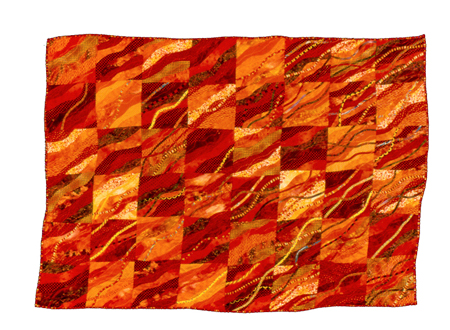On the Quiltart list this morning a member described a group project which in truth is better termed a collaboration. Whatever you call it though – this project required identification of common goals and comittment to achieving them through a group-made art quilt. What was missing from the post is any analysis of how the idea came up, how the group came to decide to carry it out, and why – what the expectations of the group were to start with. Clearly some dropped out because of technical challenges faced, and others didn’t drop out because of loyalties they felt to the group. Deeper examination before hand, though, might have meant the project didn’t happen at all and at least some of the group may not have learned what they did in the process.
Some of the real problems such projects can present are described in April’s words: “We all learned quite a bit along the way as this piece was way outside the comfort zone of all of us. I think that the piece will be quite amazing when it is completed, but it has been quite a struggle seeing it to fruition. Some people dropped out as soon as things became difficult and challenging; and others stuck with it even though they had no real interest in the project, but they were reluctant to abandon the group. It has been an interesting example of group dynamics to say the least. But it doesn’t really matter, as we are all still close friends.” You can visit the April Sproule post to find out more about their project, and see pics of how it developed technically.
In my early art quilt making days I belonged to a small SE Denver group we called “Quilt Explorations”, which we formed to explore non-traditional quiltmaking, and we focused on design in particular. We often set ‘themes’ for monthly individual exploration, and participation was optional, so the results were truly individual, and varied depending on each person’s interest and drive, time available, etc. The most successful theme, where everyone was enthused to produce something, was based on the b/w picture of the front end of a gorgeous vintage car given to each of us by the member who suggested the exercise.. We each took some element from that photo on which to at least design a small quilt, even if time was too short to actually make it. Everyone came back a month later with at least the design, most had started and some had completed a small quilt. After 2 months we had a collection of about 10 finished quilts. At the next group exhibition these were all hung together to show the diversity of results when people work from exactly the same initial image. I don’t still have that photo, but found this image of the kind of pic we all received:
In about 1991-2 I was in love with inserted straight strips, having not yet heard of life-transforming freehand or improvisational piecing which prompted the technical experiments to achieve the curvy inset strips characteristic of my 1992+ Colour Memories quilts. With strips on my mind ,the headlights of the car caught my attention. I produced this small wall quilt about 50cm sq. I called ‘Strip Lighting’
We never did a group collaboration – I doubt anyone would have suggested it as were were all clearly set along our own paths when the group came together, and such a project would have felt a diversion of dubious value from our individual goals. I have never been drawn to a collaborative project to produce a work / works of art, and maybe will explore this in a later post…. and perhaps I need to do some self examination on the matter first!






